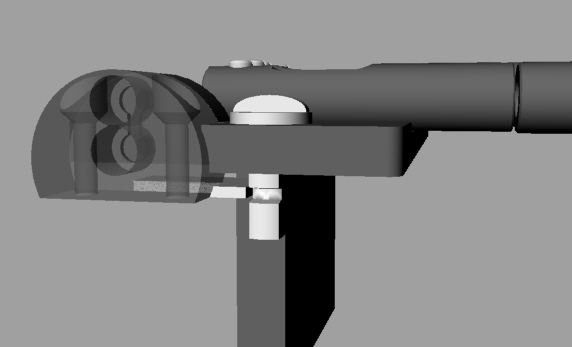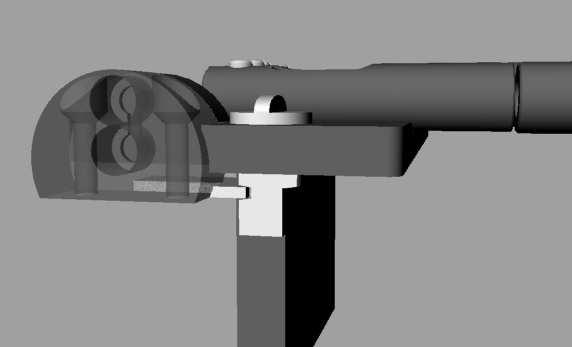Another world first: an easy to use dual-mode locking mechanism for a top-mount tremolo. While at NAMM, Ziv Cohen, Creative Director at an internet outfit, came around to the .strandberg* booth. After seeing the two holes in the new tremolo (giving the option of mounting the tremolo arm on either side for optional left-hand use), he said that “why don’t you give an option to mount a screw there to make it non-floating?” What an awesome idea! I could easily supply an extra wood screw that you could screw into the wood just under where the hole would end up, and then mount a screw in the hole. By tightening the springs and adjusting the screw, the position of the tremolo can be adjusted, and it can be made dive-only.
But on the flight back, I thought a little more. So, here for your comments, please check out the “Tremolock” option for the EGS Pro tremolos.
In the unlocked position, the tremolo pivots freely, both down and up:

Turn the knob a quarter of a turn to make it dive only:

Turn the knob a half turn to lock it completely:

The Tremolock consist of a small plate that is mounted flush in the body of the guitar, against the mounting post, to ensure that it is placed in the exact correct position, and the rotating locking axle (the white pieces in the images above). It remains to be worked out how to manufacture this in order to obtain a smooth and firm action throughout the life-time. Suggestions are gladly accepted – I will be prototyping this in the very near future.
Along with an easy-to-use spring tension adjustment mechanism, there is no telling how good this tremolo will be. Note that you don’t even have to limit yourself to headless constructions – just don’t use the tuners on the tremolo if you have conventional tuners on the headstock.




This is a wonderful idea! I’m a happy user of the tremol-no system. It’s like my secret weapon :p. However, the tremol-no has some little disadvantages:
– it adds some friction, which reduces “fluttering”
– it uses a spring slot
– it takes a considerable amount of time to set it right
– you can’t see if it is locked or not while you are playing (I know, it sounds stupid, but some times I leave the guitar with the bridge fully locked and then I try to dive bomb the next time I play it. Not pretty)
– you have to leave the springs route open in order to access the screws (actually, it doesn’t matter to me, but some prefer the springs hidden for aesthetics reasons)
Your system seems to overcome all of these inconveniences and I like the idea of the full OEM integration.
My only concern is about the up movement range. Wouldn’t the locking axle hit the locking plate when you try to dramatically rise the pitch like, well, Steve Vai or Darrell?
Man, I love how your mind works. Please, keep up doing things like this!
@Anibal: I have tried to overcome all of these shortcomings in my solution. Note that it is still in the prototyping stage. The backwards bending range is not as high on these tremolos as on some others – I would recommend them for a little more subtle bending. There are some nice tremolo effects in http://youtu.be/skrqC6EiSz4 and http://youtu.be/Mlwpf-Gd6ko
I loved the flutter :D. I’m surprised about the “limited” backward range… I would really like to test one by myself… I’ll definitely try to travel to Buenos Aires next month to meet you. Do you have any idea of what could be the limiting factor? Maybe the placement of the fulcrum point? Or is it the spring block hitting the wood?
On another topic, looking at the tuner housing of your bridges and the possibility to block the bridge brought the image of the EVH D-Tuna to my mind. Wouldn’t be wonderful if you could build something similar integrated in the system? Just a though…
It is the construction (i.e. placement of fulcrum point in relation to the post) that is limiting the backwards action. Nevertheless, it give you 2 1/2 whole tones on the thicker strings, i.e. you can pull the G-string up to a C. I have had the same idea for a d-tuner myself… 🙂
Fortunately in this case, we have different meanings for the word subtle :p. When you said it had limited range I thought you where talking about a 2nd or minor third. A 4th in the G string is sufficient, a 4th in the B string would be great.
Now is official, I NEED this tremolo. I’ll send you an email right away
Very clever design. I hope to see these implemented in many more guitars.
I wonder whether the tonal characteristics of the instrument will change when going from the “free” to the “locked” mode…
Any inputs on this?
That is an interesting thought. This prototype taught me a lot, and the revised version (that I hope to put into production) will be locking the entire tremolo block. This might well impact on the sound in a way that can be heard. Early experiments with different tremolo block materials yielded substantial changes in the tonal characteristics of the instrument.
Is this design still in the works? I would love to see it appearing on the bridges, especially with the fanned fret tremolo production models making their way to the market.
It’s back on the drawing board. Working on several design alternatives, which will hopefully see the light of day soon!